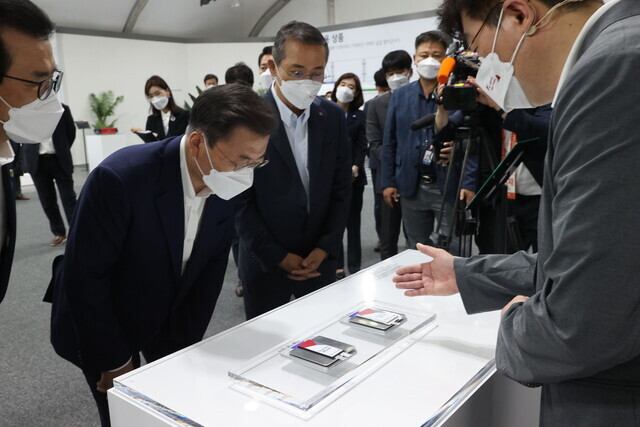hankyoreh
Links to other country sites 다른 나라 사이트 링크
Moon pledges to make S. Korea world’s No. 1 battery maker by 2030, announces tax breaks, R&D subsidies

South Korean President Moon Jae-in stated his aim Thursday of making South Korea into “the world’s number one battery country in every sense by 2030.”
“The global battery market has doubled in size over the past five years and is predicted to surpass the memory semiconductor market by 2025,” he noted.
His remarks came amid his announcement of a “K-battery development strategy” focusing on incentives to companies, including tax deduction benefits of up to 50% for research and development investment.
Moon presented his development strategy during a visit that day to an LG Energy Solution factory in Ochang, North Chungcheong Province.
“Batteries are rapidly rising to assume a central place in future industry,” he said.
LG Energy Solution currently ranks first globally with a 25.9% share of the world battery market.
Noting “predictions that the global battery market will reach US$350 billion by 2030, or eight times its current scale,” Moon said the situation was “both a tremendous opportunity and at the same time a challenge.”
“The key to carbon neutrality also lies in batteries,” he added.
“Advancements in the battery technology that will be crucial to electric vehicles and other future means of transportation are a driving force transforming the South Korean economy into a leading economy,” he said.
The “K-battery development strategy” announced by the administration that day included three main areas: R&D efforts to support the commercialization of all-solid-state and other next-generation batteries, establishing an “innovation fund” for joint government/non-government R&D, and establishing a battery recovery system.
It is South Korea’s second national core industry strategy to emerge in response to the current race to establish global supply chains, coming on the heels of the “K-semiconductor strategy” announced in May.
At an expanded meeting of economy-related ministers on June 28, Moon designated semiconductors, batteries and vaccines as national strategic technology areas, announcing support plans that included tax breaks of up to 20% for facility investment.
“The US and the countries of Europe have gone beyond efforts to attract investment and have now begun fostering their own battery companies,” he said.
“One global EV maker after another has been declaring their plans for independent battery production,” he added.
Moon also referred to the past example of South Korea “surpassing Japan in 2011 to achieve the world’s largest share of the small battery market,” as well as the current “battle with China for leadership in medium- to large-sized batteries.”
“Our aim is clear: to become the world’s number one battery country in every sense by 2030,” he said.
Moon previously showed his interest in the battery industry with a visit to an SK Innovation battery factory in Georgia while returning to South Korea after a summit with the US last May.
A report published by the White House last month on its analysis of supply chains for semiconductors, batteries, pharmaceuticals, and rare earth elements rated batteries as a promising industry for high-quality job creation, as well as a key means of responding to climate change.
It was a signal of the great importance the battery industry holds in global economic competition. As of 2020, South Korea accounted for a 44.1% share of the world battery market, followed by China with 33.2% and Japan with 17.4%.
Stressing that the South Korean economy had “developed in the past by turning global market changes into opportunities,” Moon said that the battery industry would “definitely develop into a ‘second semiconductor industry’ that creates an even greater future for the Republic of Korea.”
By Lee Wan, staff reporter
Please direct comments or questions to [english@hani.co.kr]

Editorial・opinion
![[Column] Park Geun-hye déjà vu in Yoon Suk-yeol [Column] Park Geun-hye déjà vu in Yoon Suk-yeol](https://flexible.img.hani.co.kr/flexible/normal/500/300/imgdb/original/2024/0424/651713945113788.jpg) [Column] Park Geun-hye déjà vu in Yoon Suk-yeol
[Column] Park Geun-hye déjà vu in Yoon Suk-yeol![[Editorial] New weight of N. Korea’s nuclear threats makes dialogue all the more urgent [Editorial] New weight of N. Korea’s nuclear threats makes dialogue all the more urgent](https://flexible.img.hani.co.kr/flexible/normal/500/300/imgdb/original/2024/0424/7317139454662664.jpg) [Editorial] New weight of N. Korea’s nuclear threats makes dialogue all the more urgent
[Editorial] New weight of N. Korea’s nuclear threats makes dialogue all the more urgent- [Guest essay] The real reason Korea’s new right wants to dub Rhee a founding father
- [Column] ‘Choson’: Is it time we start referring to N. Korea in its own terms?
- [Editorial] Japan’s rewriting of history with Korea has gone too far
- [Column] The president’s questionable capacity for dialogue
- [Column] Are chaebol firms just pizza pies for families to divvy up as they please?
- [Column] Has Korea, too, crossed the Rubicon on China?
- [Correspondent’s column] In Japan’s alliance with US, echoes of its past alliances with UK
- [Editorial] Does Yoon think the Korean public is wrong?
Most viewed articles
- 1‘We must say no’: Seoul defense chief on Korean, USFK involvement in hypothetical Taiwan crisis
- 2N. Korean delegation’s trip to Iran shows how Pyongyang is leveraging ties with Moscow
- 3Amnesty notes ‘erosion’ of freedom of expression in Korea in annual human rights report
- 4[Column] Park Geun-hye déjà vu in Yoon Suk-yeol
- 5‘Weddingflation’ breaks the bank for Korean couples-to-be
- 6[Reportage] On US campuses, student risk arrest as they call for divestment from Israel
- 7[Editorial] New weight of N. Korea’s nuclear threats makes dialogue all the more urgent
- 8Why Korea shouldn’t welcome Japan’s newly beefed up defense cooperation with US
- 9[Guest essay] The real reason Korea’s new right wants to dub Rhee a founding father
- 10Will NewJeans end up collateral damage in internal feud at K-pop juggernaut Hybe?